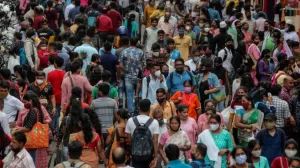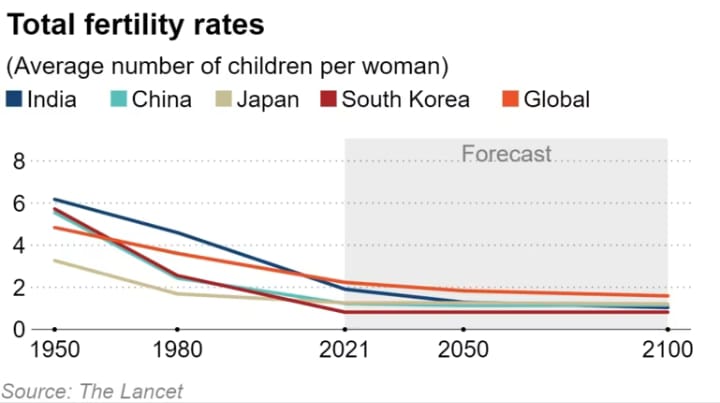India’s total fertility rate, which measures the average number of births per woman, plummeted from nearly 6.2 in 1950 to just under 2 in 2021, and is projected to fall further to 1.29 by 2050 and 1.04 by 2100, according to a new global study published last week in The Lancet journal. A fertility rate of 2.1 is generally considered replacement level, and the shift could have major ramifications as the working population shrinks while older age groups expand.

Picture for representational purpose only
India is not an outlier but rather part of a global downtrend in fertility rates to 2.2 on average in 2021, from 4.5 in 1950, according to the report. The global figure is projected to slide further to 1.8 in 2050 and 1.6 in
For policymakers in New Delhi, however, experts say the rapid decline in fertility coupled with an increase in life expectancy will pose several challenges, such as providing adequate social security and health care for seniors and creating employment opportunities for them to harness their skills. Social imbalances, such as the wealth gap and a persistent preference for male children over girls, could compound the issues.
“While these challenges are still a few decades away for India, we need to start acting now with a comprehensive approach for the future,” Poonam Muttreja, chief of the Population Foundation of India, said in a statement. “Economic policies stimulating growth and job creation, alongside social security and pension reforms, will also be essential in adapting to and mitigating the impacts of declining fertility rates.”
Despite the country’s falling fertility, the United Nations expects India’s population to rise to over 1.6 billion by 2050. While a large population comes with its own set of problems, policymakers have long played up massive economic benefits India stands to gain from its bulging youth set — a so-called demographic dividend. The country is still relatively young, with a median age of a little below 30, but the pressure is on to maximize that advantage before India is caught in what is known as the middle-income trap.
That describes a situation when once-brisk economies stagnate before reaching high-income status.
Some experts fear the trap is already set, as the overall fertility trend will only exacerbate the divide between the rich and poor, who tend to have more children. “High unemployment combined with lack of quality education among the marginalized who have more kids than the rich will create a demographic disaster which will not allow India to reap the dividends of its youth population,” warned economist and professor Arun Kumar.
Likewise, Kumar added that declining fertility will be more prevalent in richer Indian states, while less wealthy states will continue to have more children. “The poor have higher infant mortality rates due to nutritional deficiencies, less educated parents and lack of access to good medical facilities. This breeds insecurity among families so they tend to bear on an average five children — against one or two by the rich — hoping that at least one child will survive.”
This asymmetry can create stark imbalances among regions and different sections of the population. Unless promptly addressed, this demographic shift will increasingly strain social security programs and the country’s health-care infrastructure, he added.
An array of factors are behind the drop in fertility, experts say.
Obesity, stress, smoking and pollution are some factors contributing to declining reproductive health. Research from health care company Nova showed that the general fertility rate in India has dropped by 20% in 10 years, with some 30 million people affected by infertility.
In addition, more and more couples are opting to start families later because of professional reasons, contributing to the lower fertility rate, said Mumbai-based in-vitro fertilization expert Dr. Soni Taneja. Demand for IVF treatments in India has been surging, with the market projected to be worth $3.7 billion by 2030, compared with $793 million in 2020, according to industry estimates.
Looking ahead, a dramatic increase in the population of senior citizens is likely to create headaches for New Delhi.
“While on the one hand, a lesser number of children being born, especially in the world’s most populous country currently hosting 1.41 billion people, can be a cause for celebration, it can trigger other challenges,” said professor Ritu Priya, of the Center of Social Medicine and Community Health at Jawaharlal Nehru University.
“A burgeoning aging population is socially and economically unviable as we’ve seen in countries like China and Japan, which are bringing in younger workers from other countries to bolster their workforce,” said the academic.
A graying society, Priya added, puts a strain on families and especially women — typically the primary caregivers — who are caught between managing kids as well as aging parents.
“Unless socio-cultural dimensions of the fertility decline are addressed holistically, and the government steps in to set up the requisite infrastructure and offer social security benefits to the elderly, the twin phenomenon of a surging aging population and plunging birth rates are a recipe for disaster,” she said.










